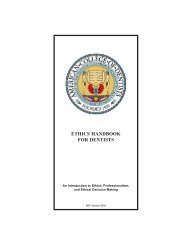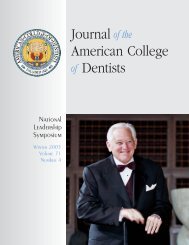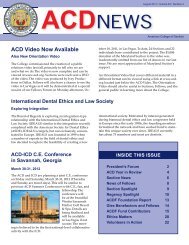Journal of the American College of Dentists
Journal of the American College of Dentists
Journal of the American College of Dentists
You also want an ePaper? Increase the reach of your titles
YUMPU automatically turns print PDFs into web optimized ePapers that Google loves.
Students’ Views on Ethics<br />
and colleagues (2001) suggested that<br />
written information be given in conjunction<br />
with verbal information, particularly<br />
to children, as <strong>the</strong>ir study revealed that<br />
children respond poorly to verbal<br />
communication alone. As mentioned<br />
previously, Kang and o<strong>the</strong>rs (2009)<br />
showed that a combination method—<br />
with written and visual information in<br />
particular, for <strong>the</strong>ir study—increases information<br />
processability and subsequently<br />
improved retention <strong>of</strong> information.<br />
There may be some benefit to presenting<br />
<strong>the</strong> information in more than one way,<br />
and <strong>the</strong> benefit may extend beyond<br />
comprehension and retention <strong>of</strong> information,<br />
as suggested by a study by Wright<br />
and colleagues (2010) that showed<br />
increased motivation in orthodontic<br />
patients who received both verbal and<br />
written information in <strong>the</strong> consent process.<br />
Evidence is still lacking and findings<br />
are not consistent, particularly when it<br />
comes to effective information presentation<br />
methods. Existing studies point to<br />
<strong>the</strong> low level <strong>of</strong> comprehension and<br />
recall <strong>of</strong> treatment information by<br />
orthodontic patients and parents, and<br />
future studies are needed to assess how<br />
this communication gap between<br />
patients and orthodontists can be<br />
diminished through more effective<br />
consultation methods. In particular,<br />
studies with a sufficiently large sample<br />
size allowing several intervention<br />
groups with different combination<br />
<strong>of</strong> methods may be <strong>of</strong> value.<br />
Conclusions<br />
Current evidence does not support <strong>the</strong><br />
claim that orthodontists are meeting<br />
<strong>the</strong>ir ethical obligation to base treatment<br />
on informed consent by patients or<br />
<strong>the</strong>ir parents.<br />
Information recall by orthodontic and<br />
orthognathic patients and parents was<br />
low, particularly regarding information on<br />
risks associated with treatment. In general,<br />
children recalled less than parents.<br />
Several studies investigated <strong>the</strong><br />
effectiveness <strong>of</strong> different modalities in<br />
presenting treatment information to<br />
patients and parents, but results are<br />
inconsistent.<br />
Due to inconsistencies in <strong>the</strong> available<br />
studies, no definitive conclusion can be<br />
drawn regarding which method is most<br />
effective when communicating with<br />
patients, and fur<strong>the</strong>r study is needed.<br />
■<br />
References<br />
Ackerman, J. L. & Pr<strong>of</strong>fit, W. R. (1995).<br />
Communication in orthodontic treatment<br />
planning: Bioethical and informed consent<br />
issues. Angle Orthodontist, 65 (4), 253-262.<br />
Baird, J. F., & Kiyak, H. A. (2003). The uninformed<br />
orthodontic patient and parent:<br />
Treatment outcomes. <strong>American</strong> <strong>Journal</strong> <strong>of</strong><br />
Orthodontics and Dent<strong>of</strong>acial Orthopedics,<br />
124, 212-215.<br />
Brons, S., Becking, A. G., & Tuinzing, D. B.<br />
(2009). Value <strong>of</strong> informed consent in<br />
surgical orthodontics. <strong>Journal</strong> <strong>of</strong> Oral and<br />
Maxill<strong>of</strong>acial Surgery, 67, 1021-1025.<br />
Cameron, C. A. (1997). Informed consent<br />
n orthodontics. Seminars in Orthodontics,<br />
3 (2), 77-93.<br />
Ernst. S., Elliot, T., Patel, A., Sigalas, D.,<br />
Llandro, H., Sandy, J. R., et al (2007).<br />
Consent to orthodontic treatment—Is it<br />
working? British Dental <strong>Journal</strong>, 202, E25.<br />
Harwood, A., & Harrison, J. E. (2004).<br />
How readable are orthodontic patient information<br />
leaflets? <strong>Journal</strong> <strong>of</strong> Orthodontics,<br />
31, 210-219.<br />
Kang, E. Y., Fields, H. W., Kiyak, A., Beck,<br />
F. M., Firestone, A. R. (2009). Informed<br />
consent recall and comprehension in<br />
orthodontics—Traditional vs improved<br />
readability and processability methods.<br />
<strong>American</strong> <strong>Journal</strong> <strong>of</strong> Orthodontics and<br />
Dent<strong>of</strong>acial Orthopedics, 136, 488.e1-<br />
448. e13.<br />
Mortensen, M. G., Kiyak, H. A., & Omnell,<br />
L. (2003). Patient and parent understanding<br />
<strong>of</strong> informed consent in orthodontics.<br />
<strong>American</strong> <strong>Journal</strong> <strong>of</strong> Orthodontics and<br />
Dent<strong>of</strong>acial Orthopedics. 124, 541-550.<br />
Patel, J. H., Moles, D. R., & Cunningham,<br />
S. J. (2008). Factors affecting information<br />
retention in orthodontic patients. <strong>American</strong><br />
<strong>Journal</strong> <strong>of</strong> Orthodontics and Dent<strong>of</strong>acial<br />
Orthopedics, 133, S61-S67.<br />
Salgo (1957). Salgo v Leland Stanford Jr.<br />
Board <strong>of</strong> Trustees, 317 P.2d 170 (Cal Ct<br />
App 1957).<br />
Thickett, E., & Newton, J. T. (2006). Using<br />
written material to support recall <strong>of</strong> orthodontic<br />
information: A comparison <strong>of</strong> three<br />
methods. Angle Orthodontist, 76, 243-250.<br />
Thomson, A. M., Cunningham, S. J., &<br />
Hunt, N. P. (2001). A comparison <strong>of</strong> information<br />
retention at an initial orthodontic<br />
consultation. European <strong>Journal</strong> <strong>of</strong><br />
Orthodontics, 23, 169-178.<br />
Wright, N. A., Fleming, P. S., Sharma, P. K.,<br />
& Battagel, J. (2010). Influence <strong>of</strong> supplemental<br />
written information on adolescent<br />
anxiety, motivation and compliance in early<br />
orthodontic treatment. Angle Orthodontist,<br />
80, 329-335.<br />
34<br />
2011 Volume 78, Number 4





